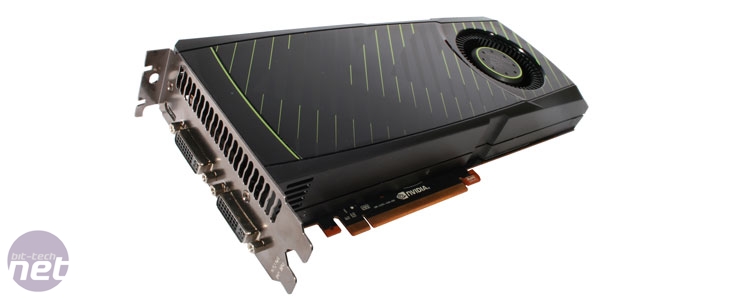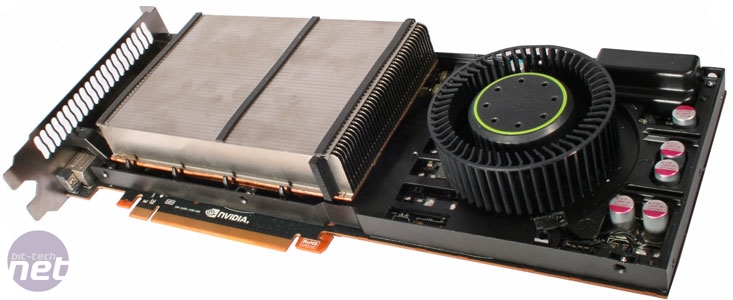
GTX 570 Performance Analysis
We weren’t sure if the GTX 570 1.3GB would be able to surpass the GTX 480 1.5GB; would be extra clock speeds and fp16 ability be enough to negate the loss of memory bandwidth and frame buffer? The answer isn’t clear-cut either way, but that’s a fantastic result for a card that costs £300 at launch rather than £420 (and upwards).In Dirt 2, the GTX 570 1.3GB had the edge of every card except the GTX 580 1.5GB and the ATI Radeon HD 5790 2GB at every resolution bar 1,680 x 1,050 with no AA where the GTX 480 1.5GB crept ahead. At 1,920 x 1,200 with 4x AA the GTX 570 1.3GB put its higher frequencies to good use, producing a minimum of 75fps and an average of 86fps. The GTX 480 1.5GB could only manage a minimum of 70fps, while the GeForce GTX 470 1.3GB that this new card replaces could only wrangle a minimum of 58fps from the game.
Moving to Call of Duty: Black Ops and the GTX 570 1.3GB’s reduced memory became much more noticeable, especially when anti-aliasing was enabled. While it was able to pip the GTX 480 1.5GB when AA was disabled, at 1,920 x 1,200 with 4x AA the GTX 570 1.3GB managed a minimum of 65fps to the GTX 480 1.5GB’s 72fps. This is an unnoticeable difference if you enable V-sync, but less performance regardless. The game wasn’t memory-limited at 2,560 x 1.600, where the GTX 570 1.3GB proved how fast it is by taking its place as second only to the GTX 580 1.5GB.
Just Cause 2 was also a game in which the lesser amount of memory hurt the GTX 570 1.3GB. At 1,680 x 1,050 with 4x AA, the GTX 480 1.5GB produced a minimum frame rate of 33fps but an average of 54fps while the GTX 570 1.3GB could only manage the same minimum but an average of 50fps. Only at 1,920 x 1,200 with 4x AA did the GTX 570 1.3GB supplant the GTX 480 1.5GB, with a minimum of 29fps rather than 27fps – this looks like an anomaly caused by a driver optimisation or bug, especially as the GTX 480 1.5GB had the higher average frame rate. The GTX 570 1.3GB was between 14 and 39 per cent faster than the old GTX 470 1.3GB in Just Cause 2, just to underline the speed of the card.
Bad Company 2 is a much more clock speed sensitive game, which meant that he GTX 570 1.3GB gave a great show. The results at 1,680 x 1,050 are a touch anomalous, as at every other resolution and AA setting the GTX 570 1.3GB outpaced the old GTX 480 1.5GB, if only by 1-2fps. The game played smoothly right up to 2.560 x 1,600 with 4x AA thanks a minimum frame rate of 26fps, and the card was the second-fastest (after then GTX 580 1.5GB) at 1,920 x 1,200 with 4x AA and beyond. At lower resolutions (1,680 x 1,050 with no AA aside) the enormous HD 5970 2GB was faster than both of Nvidia’s new top-end, single-GPU cards.
Power and Thermals
As well as the excellent gaming performance, the GTX 570 1.3GB also delivered on the power consumption and thermal performance front too. An Idle power consumption of 150W matches the GTX 580 1.5GB and a load power consumption of 330W, while still higher than any single-GPU ATI card, is 11W less than the GTX 470 1.3GB and a significant 33W less than the GTX 580 1.5GB.We didn’t have any worries regarding cooling, as we were happy to see the GTX 570 1.3GB performed just as well as it’s bigger brother. An idle delta T of 19°C is fine, but the peak delta T of 56°C mirrors the improvement shown by the GTX 580 1.5GB over the first generation of Fermi cards. As with the GTX 580 1.5GB, the fan was also pleasantly quiet; it was almost inaudible when the card was idle and produced a low background hum when the card was under load.

MSI MPG Velox 100R Chassis Review
October 14 2021 | 15:04










Want to comment? Please log in.